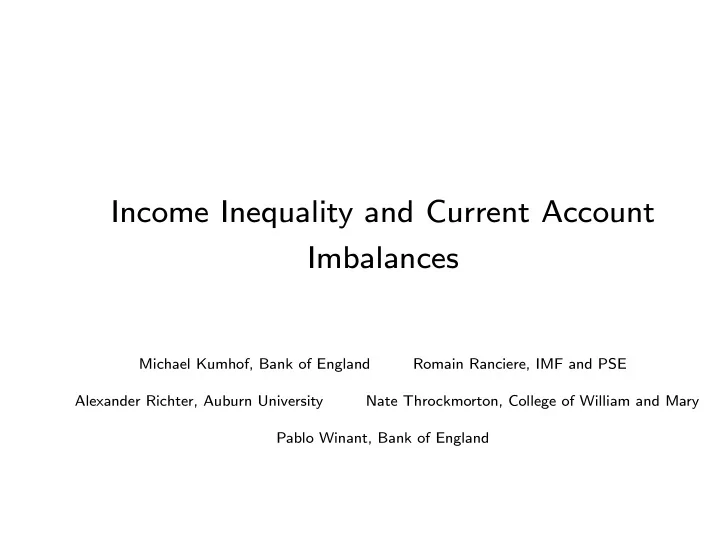

Income Inequality and Current Account Imbalances Michael Kumhof, Bank of England Romain Ranciere, IMF and PSE Alexander Richter, Auburn University Nate Throckmorton, College of William and Mary Pablo Winant, Bank of England
The views expressed herein are those of the authors and should not be attributed to the Bank of England or the IMF.
1 Introduction • Global external imbalances often mentioned as one of the reasons for the financial crisis. • Competing explanations for U.S. current account deficits: — Low public and private saving rates in the United States. — High saving rates in the rest of the world. — Global underinvestment. — Demographics. — Productivity. — U.S. dollar’s world reserve currency status.
• But persistently high CA deficits not limited to US: Many other cases, es- pecially Anglo-Saxon. • Common factors for these countries: — Steep increase in income inequality over recent decades. — Finance-driven rather than export-driven growth models. • Our empirical work and model simulations confirm this: — Income inequality can trigger large CA deficits under ∗ redistributive shocks that drive up asset values, and ∗ a large role of financial markets in the economy. — CA surpluses under opposite set of conditions, ∗ redistributive shocks purely to labor incomes, and ∗ small role of financial markets in the economy.
2 Data 2.1 Rise in Global Income Inequality • Income inequality measured by top 5% income shares. • Anglo-Saxon Countries: U-shaped pattern, rising inequality since late 1970s. • Continental Europe and Japan: L-shaped pattern, no large increases in inequality. • Southern European and Nordic Countries: L/U-shaped pattern, recent in- creases in inequality.
US UK Canada Australia New Zealand 45 40 35 30 25 20 15 10 1910 1920 1930 1940 1950 1960 1970 1980 1990 2000 (a) Anglo-Saxon Countries (U-shaped) France Germany Netherlands Switzerland Japan 45 40 35 30 25 20 15 10 1910 1920 1930 1940 1950 1960 1970 1980 1990 2000 (b) Continental Europe and Japan (L-shaped) Sweden Finland Norway Spain Portugal Italy 45 40 35 30 25 20 15 10 1910 1920 1930 1940 1950 1960 1970 1980 1990 2000 (c) Southern Europe and Nordic Countries (U/L-shaped) Figure 1: Income Share of Top 5 Percent by Country (in percent)
2.2 Rise in Global Current Account Imbalances • CA Deficit Countries: — US, UK, Italy, Ireland and Portugal. — These countries also experienced rising top income shares. • Balanced CA (or Surplus) Countries: — Germany, Japan, Switzerland and France. — These countries also exhibited stable top income shares.
US UK Canada Australia Ireland New Zealand 20 15 10 5 0 −5 −10 −15 1980 1985 1990 1995 2000 2005 (a) Anglo-Saxon Countries (U-shaped) France Germany Netherlands Switzerland Japan 20 15 10 5 0 −5 −10 −15 1980 1985 1990 1995 2000 2005 (b) Continental Europe and Japan (L-shaped) Sweden Finland Norway Spain Portugal Italy 20 15 10 5 0 −5 −10 −15 1980 1985 1990 1995 2000 2005 (c) Southern Europe and Nordic Countries (U/L-shaped) Figure 4: Global Current Account Imbalances (percent of GDP)
10 Switzerland (79−95) 8 R 2 : 0.62305 Change in Current Account Balance 6 Sweden (79−00) 4 Canada (79−00) Netherlands (81−99) Japan (79−00) France (79−00) Italy (79−00) 2 0 Germany (80−98) Spain (79−00) Australia (79−00) New Zealand (79−00) −2 UK (79−00) US (79−00) −4 −6 Portugal (79−00) 0 2 4 6 8 10 12 14 Change in Top 5% Income Share Figure 5: Changes in Current Accounts and Top Income Shares (in percent
2.3 Current Account Regressions • Baseline = IMF’s External Balance Assessment (EBA) methodology: — Comprehensive set of explanatory variables. — Pooled GLS with panel-wide AR(1) correction. — Annual data, 49 countries, 1986-2010. — We mostly use 19 OECD economies.
• Baseline regressors: Conventional results. • Including top 5% income share (TIS): — TIS coefficients significant and robust: ∗ 10 pp increase in TIS deteriorates CA/GDP by 1.25 pp. ∗ US/UK top income shares increased by around 10 pp. — Other coefficients very similar to baseline. • Including the size of domestic financial markets: — Used as interaction term with income inequality. — Inequality - CA deficit link stronger with larger financial markets. • These results are consistent with model simulation results below.
Recommend
More recommend